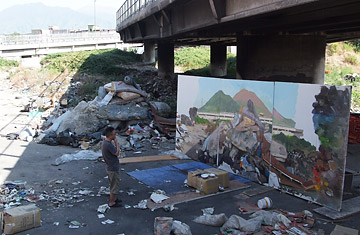
Liu Xiaodong looks at his painting of trash in Naples.
Liu Xiaodong was too lost in his delicate brushstrokes — too deep in the trash heap beneath an East Naples underpass — to notice his visitors: a pair of helmetless (and humorless) teenagers, who had quietly rolled in on a moped as the star Chinese painter added touches of color to his latest en plein air work of social neo-realism.
The same stone-faced duo had shown up about an hour before sunset on each of the six days that Liu had been working on his unlikely rendering of Naples' notorious garbage. They said nothing and showed no interest in talking with the artist or any of his eight assistants, but stayed long enough to look everything and everyone over — and to be sure they were noticed. They were performing a ritual familiar in the troubled neighborhoods of southern Italy, scouting for local mob bosses and asserting control over the "territorio."
This particular slice of territory has gotten more attention over the past year than any of the locals — good guys and bad — might have wanted. Last spring's images of garbage covering entire blocks and neighborhoods in revolt were beamed around the world. News reports blamed the Camorra crime syndicate, government mismanagement, faraway profiteers and ingrained local apathy for the troubled coastal city's worst-ever waste-removal crisis. The broader implication was that the modern consumer lifestyle is a ticking environmental time bomb. Watching the drama unfold on TV in Beijing, Liu saw the makings of one of his blunt but beautiful site-specific works of social commentary.
"Modern life gives us many things," the easygoing 45-year-old said on the van ride to his final day of painting. "But I've always wondered where does the trash go? Europe may be the most civilized, most mature society on the planet. So why is there this [waste] problem? It's not supposed to be like this."
Liu has risen to the top of the contemporary art world — in April, he broke a record for a mainland Chinese painting when one of his works fetched $8.2 on auction. His subject matter deals invariably with the consequences of modernity, depicting the forgotten faces of peasants in the Tibetan desert, or families displaced by the rising waters of the massive Three Gorges damn project. He's also done portraits of prostitutes in Thailand, and high school students in Boston. Says Morgan Morris, the Rome-based curator of this latest project: "Every time there's something coming to a head, he captures it."
Still, subtly exploring sensitive issues in a China still prone to squash dissent is one thing; painting on the streets of Naples requires a different kind of courage. "This is under control of the clan," says one local, nodding toward the mounds of illegally dumped trash being rendered iconic by Liu beneath the exit ramp of State Highway SS162. "It's the Sarno family: they say yes or no if this gets cleaned up or not."
The mob might also have veto power over whether a foreign painter gets to set up his outdoor studio on its turf. They're unlikely to have known that Liu was a millon-dollar painter — his support team telling anyone who asked that the Naples work was a "university project." (Liu does teach at Universtiy of Beijing.) Still, one person had told the local driver of the artist and crew, "We know where they're staying." In the end, the project appeared to have garnered a tacit approval, because by the final day, it had become clear that no one in the neighborhood was going to disturb the completion of the giant three-panel work. (One worry was that the trash would be cleaned up overnight.)
In the event, the greatest danger to Liu and his crew came not from local mafiosi, but from the canker sores, rashes, flu and other maladies resulting from spending six hours a day working amid rotting garbage. With the Mt. Vesuvius volcano looming in the background, Liu titled the work, Shang Huo (Festering Heat). And the vitality of the image, he says, derives from it being created amid the stench of its subject matter.
"When you are inside, you rest, you let time pass, and you will lose something," he said, through a translator. "Here, you just let it catch your eyes in this place. I can smell, I can hear. It is just now. Not before. Not a memory."
The centerpiece of the 19-by-24-foot trashscape is a mountain of discarded mattresses. Shredded, torn and piled one on top of another, he renders them both distasteful and somehow comforting. Adding a few strokes to capture a surprising softness of one brown fouton, Liu steps back and looks over his work. "Everything has been used by humans," he says. "You feel it in your heart."
Kicking through the dump turns up Panama banana crates and Sicilian oranges, boxes from made-in-Vietnam Nike sneakers, Dior perfume from France, and Glutatione and Metoclopramide medicines bottles from Milan. No sign of any Made in China products. Of course, just like the empty bread bag and twisted remains of a pink baby stroller, Liu Xiaodong's latest product was Made in Naples. And like most of his paintings, it will likely be sold in China.
